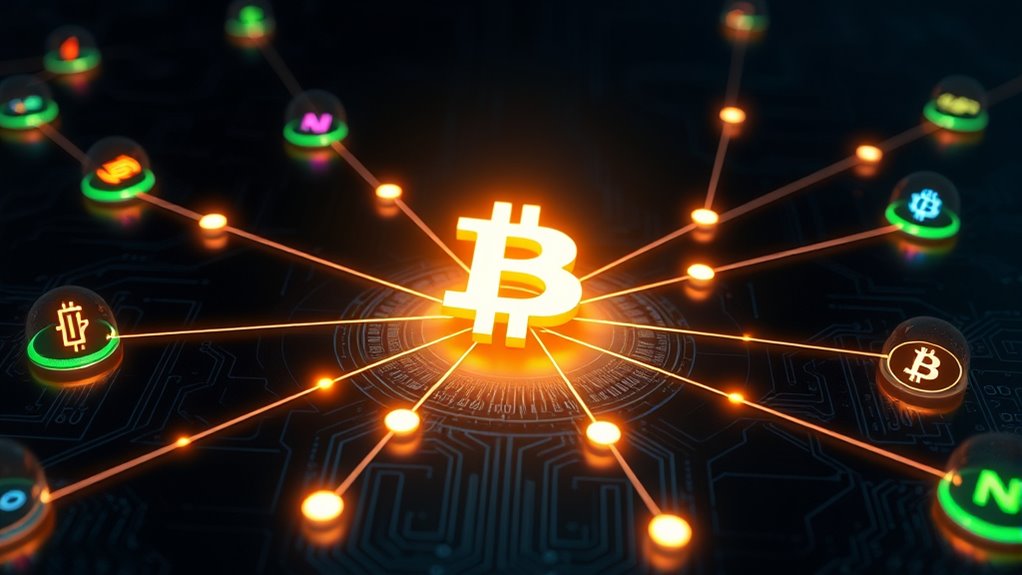Trust-minimized relays are changing how you bridge Bitcoin to other blockchains by enabling secure, decentralized transfers without relying on centralized exchanges or custodians. They work through distributed verification processes, eliminating single points of failure and reducing risks like theft. These relays support seamless asset transfer across networks, making Bitcoin more versatile and integrated into DeFi. Want to see how these innovations could transform your crypto experience? Keep exploring to learn more.
Key Takeaways
- Trust-minimized relays enable secure Bitcoin transfers without relying on centralized custodians.
- They rely on distributed verification systems to enhance security and reduce single points of failure.
- These relays facilitate seamless cross-chain asset transfers, expanding Bitcoin’s interoperability.
- They support DeFi integration by enabling wrapped Bitcoin and other synthetic assets across networks.
- The rise of trust-minimized relays improves security, reduces costs, and simplifies cross-chain Bitcoin usage.

Bridging Bitcoin to other chains opens new opportunities for users by enabling seamless asset transfer across multiple blockchain networks. This process relies on advanced cross-chain technologies that connect different blockchain ecosystems, making it easier to move assets without relying on centralized exchanges. One of the key innovations in this space is the use of decentralized relay systems, which serve as trust-minimized pathways for transaction validation. Unlike traditional bridges that depend on single entities, these decentralized relays eliminate the need for centralized custody, reducing the risk of theft or failure. By distributing transaction verification across multiple nodes, they create a more resilient and secure infrastructure for Bitcoin transfers.
Decentralized relays enable secure, trust-minimized Bitcoin transfers without centralized custody.
Security measures are essential when bridging assets, especially with the high value associated with Bitcoin. Regular audits and thorough security protocols help ensure that the bridging services remain trustworthy. These audits evaluate the smart contracts and underlying protocols to identify vulnerabilities before malicious actors can exploit them. Many reputable bridging solutions also implement strict security standards, including multi-signature schemes and threshold signature schemes (TSS), which distribute control and safeguard transactions. These mechanisms prevent any single point of failure, making the system more resistant to attacks. Additionally, bridges adopt rigorous security practices to maintain compliance and protect user assets, fostering confidence in the technology. Robust security protocols are vital for maintaining trust in cross-chain transfer solutions, especially given the increasing value and popularity of Bitcoin. Implementing interoperability standards further enhances the integration process, ensuring compatibility and seamless operation across diverse blockchain networks.
Major blockchain networks like Ethereum, BNB Chain, and Bitcoin sidechains support bridging solutions, expanding Bitcoin’s reach beyond its native network. These integrations allow Bitcoin holders to participate in decentralized finance (DeFi), opening doors to lending, borrowing, and liquidity pools. By bridging Bitcoin, users gain access to a broader spectrum of DeFi applications, increasing its utility and liquidity. The process is designed to be user-friendly, often involving mechanisms like lock-and-mint, where Bitcoin is locked in a smart contract, and a wrapped or synthetic version is minted on the target network. These wrapped tokens behave like Bitcoin but operate within the destination chain, facilitating seamless asset transfer.
The emergence of cross-chain standards aims to unify asset behavior across multiple networks, making future integrations more straightforward. This standardization enhances interoperability, ensuring that assets like Bitcoin maintain consistent functionality regardless of the chain. Many bridging solutions also emphasize cost efficiency, offering low fees and minimal slippage to keep transactions economical. Users benefit from convenience, as they no longer need to manually wrap tokens or switch networks, simplifying cross-chain transfers. Overall, bridging Bitcoin using decentralized, trust-minimized relays strengthens the ecosystem, making Bitcoin more versatile and accessible across the decentralized landscape.
Frequently Asked Questions
How Do Trust‑Minimized Relays Differ From Other Bridging Methods?
Trust-minimized relays differ from other bridging methods by using cryptographic verification instead of relying on centralized or federated operators. You maintain protocol-level verification through light clients on both chains, which reduces trust assumptions. Unlike custodial or federated bridges, these relays depend on the security of each blockchain’s consensus, making attacks more costly and less likely, and enabling more secure, direct cross-chain transfers without intermediaries.
What Are the Main Security Challenges of Trust‑Minimized Relays?
Trust-minimized relays face significant security challenges because their safety depends on honest participants and precise synchronization. You need to watch out for timing attacks, double-spending, and race conditions caused by delayed or inconsistent data. Additionally, these systems are vulnerable if participants collude or if operational security is compromised. You must also consider economic incentives, as attackers exploit incentive misalignments through DoS attacks or fraudulent activities to undermine cross-chain trust.
Can Relays Support Cross-Chain Smart Contract Interactions?
Think of relays as bridges connecting islands—you need them sturdy enough to handle traffic between separate lands. Yes, relays can support cross-chain smart contract interactions by securely transmitting data and assets across different blockchains. They use decentralized verification and cryptographic proofs to guarantee trustless communication. This setup enables seamless, atomic transactions, allowing smart contracts on one chain to reliably interact with those on another without relying on centralized intermediaries.
How Do Relays Handle Bitcoin’s Transaction Finality?
You might wonder how relays handle Bitcoin’s transaction finality. They do this by verifying that transactions are confirmed on Bitcoin before acting on them on the target chain. Since Bitcoin’s finality is probabilistic, relays wait for multiple confirmations—usually six—to guarantee security. They also incorporate security measures to prevent double-spending and adapt to latency, ensuring the process remains dependable despite Bitcoin’s inherent confirmation times.
What Are the Future Developments in Trust‑Minimized Relay Technology?
You’re wondering what’s next for trust-minimized relays? Well, expect a future filled with interoperability magic, where chains chat seamlessly without external validators. Security will get tighter, scalability faster, and quantum-proof cryptography will keep your assets safe from sci-fi threats. Enterprises will jump on board, and AI will optimize smart contracts. Basically, trust-minimized relays will keep evolving, making blockchain connections smoother, smarter, and more secure than ever—no third-party needed.
Conclusion
So, you thought bridging Bitcoin to other chains was a foolproof way to expand its reach? Turns out, trusting these trust-minimized relays might be your best bet—ironically, since they’re designed to minimize trust. Yet, even with the clever tech, you’re still relying on complex systems that could stumble. Maybe the real lesson is that, in crypto, trusting less doesn’t always mean trusting nothing. Who knew, right?









